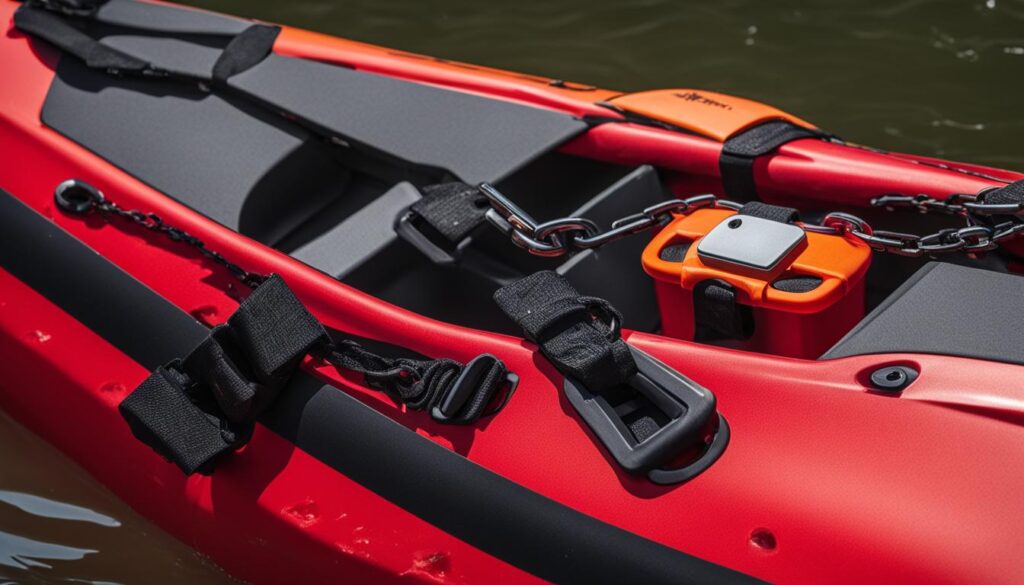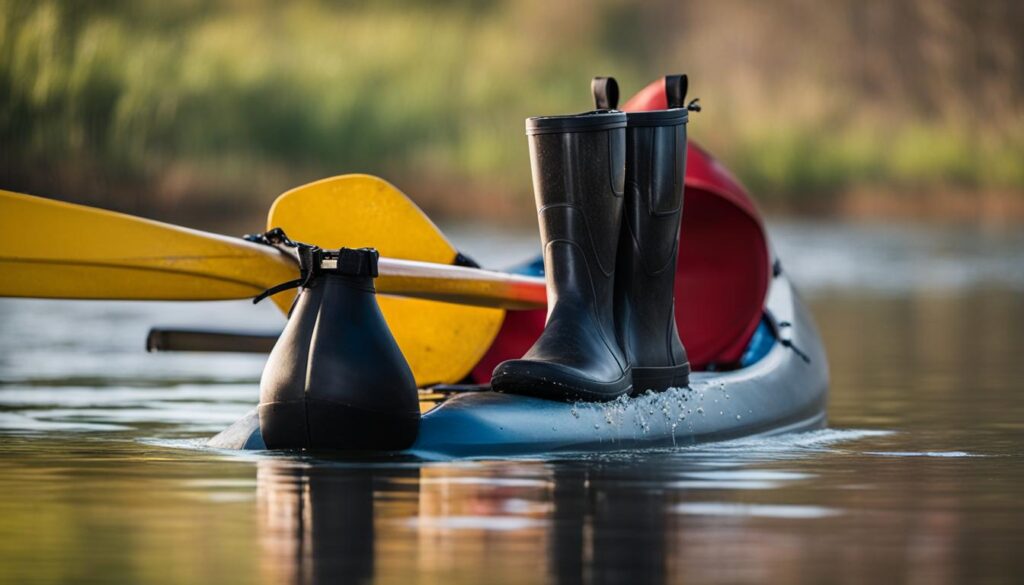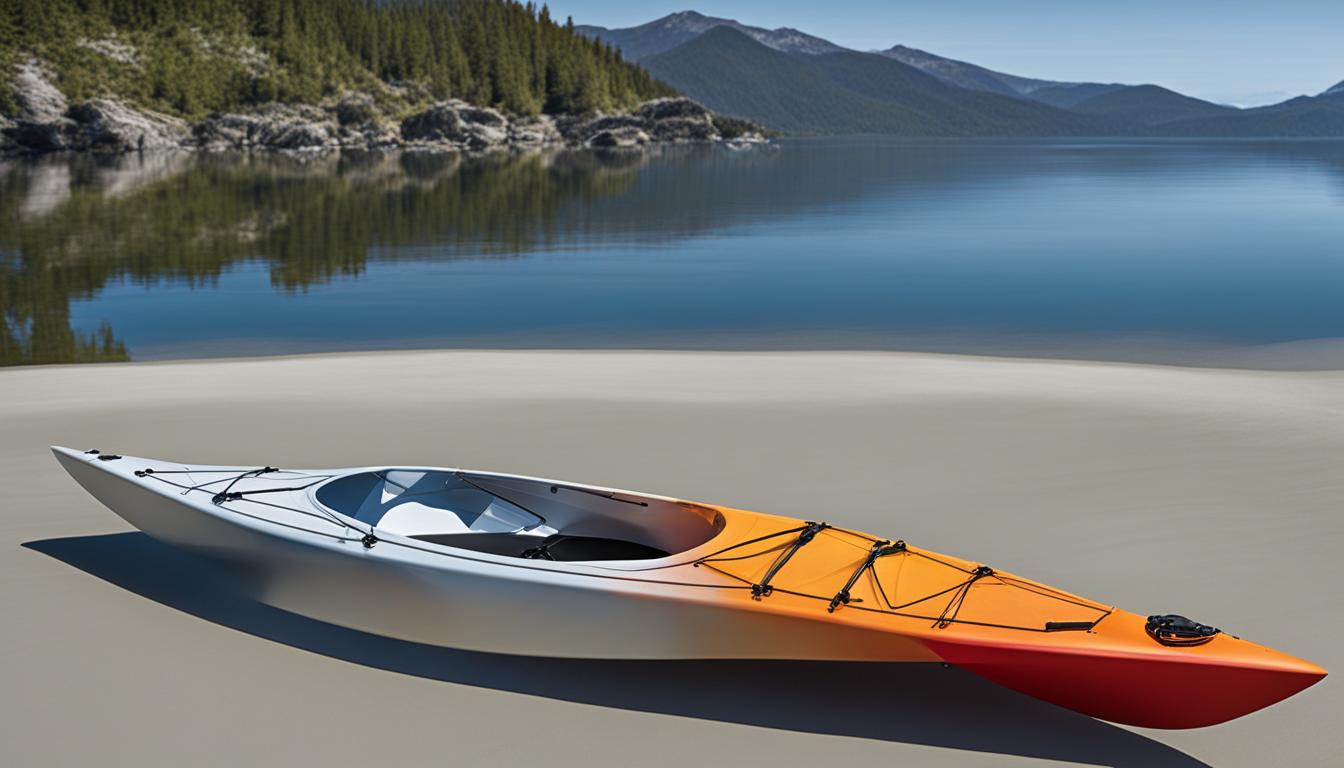Kayak construction can be a rewarding DIY project, but it’s essential to be aware of the common challenges that beginners and novices often face. Making mistakes during the construction process can lead to poor performance and safety issues. To ensure a smoother and safer kayak building experience, it’s important to follow some basic pointers and avoid these pitfalls. Let’s explore some of the most common challenges and learn how to overcome them.
Key Takeaways:
- Use the paddle correctly to improve performance on the water.
- Position the drip rings closer to the blade to prevent water dripping down the shaft.
- Be prepared for capsizing by wearing a properly fitted lifejacket and appropriate clothing.
- Secure your valuables in a dry bag and consider using a waterproof cellphone case.
- Learn self-rescue techniques or take a self-rescue course.
Using the Paddle Correctly
Using the paddle upside down or backward is a common mistake that many kayakers make. Not only does it affect the aesthetics, but it also decreases the power and efficiency of your strokes over time. The blade design of a kayak paddle is meant to distribute the force of the water evenly, providing a steady pull. To avoid this mistake, always check the logo on the blades of your paddle. If the logo is upside down, it means your paddle is upside down too!
Using the paddle correctly is essential for optimal performance on the water. When holding the paddle, make sure the concave side of the blade is facing you while the convex side is facing away. This position allows the paddle to slice smoothly through the water, providing the maximum amount of propulsion with each stroke. By using the paddle correctly, you’ll improve your efficiency and have a more enjoyable kayaking experience.
To visualize the correct paddle position, imagine cutting through a cake. The concave side of the paddle blade is like the sharp edge of a knife, cutting through the water effortlessly. Remember, using the paddle correctly not only enhances your performance but also prevents unnecessary strain on your muscles. So, before you set off on your next kayaking adventure, ensure that you are using your paddle the right way.
Mistake: Using the paddle upside down
“Using the paddle upside down not only affects your performance but also decreases efficiency. Remember to always check the logo on your paddle blades to ensure they are facing the correct way.”
Positioning Drip Rings
When it comes to kayaking, preventing water dripping down the shaft and up your arm is essential for a comfortable and enjoyable experience. This is where drip rings come into play.
Some paddlers make the mistake of repositioning the drip rings as hand markers, but this compromises their effectiveness. To properly prevent dripping, the drip rings should be positioned closer to the blade. Aim for approximately a hand-width of space between the blade and the ring for optimal placement.
By positioning the drip rings correctly, you can ensure that water is directed away from your body, keeping you dry and comfortable throughout your kayaking adventures.
The Importance of Proper Drip Ring Positioning
Properly positioning the drip rings on your kayak paddle is key to preventing water from dripping down the shaft and up your arm. When positioned correctly, drip rings effectively redirect water away, keeping you dry and improving your overall kayaking experience.
Tips for Positioning Drip Rings
Here are some tips to ensure that you position your drip rings correctly:
- Place the drip rings closer to the blade rather than using them as hand markers.
- Aim for approximately a hand-width of space between the blade and the drip ring.
- Adjust the position of the drip rings as needed to find the optimal placement for your paddling style and comfort.
| Benefits of Proper Drip Ring Positioning |
|---|
| Prevents water from dripping down the shaft and up your arm |
| Keeps you dry and comfortable during your kayaking adventures |
| Improves overall paddling efficiency |
Properly positioned drip rings are essential for redirecting water away from your body, ensuring a dry and enjoyable kayaking experience.
By following these tips and positioning your drip rings correctly, you can prevent water from dripping and enhance your paddling experience. Enjoy your time on the water with dry arms and a more enjoyable kayaking adventure.
Being Prepared for Capsizing
Kayaking can be an exciting and enjoyable outdoor activity, but it’s important to be prepared for unexpected situations, such as capsizing. By taking necessary safety precautions, you can ensure a safe and comfortable experience on the water.
Wearing a Lifejacket
One of the most vital safety measures when kayaking is wearing a properly fitted lifejacket, also known as a Personal Flotation Device (PFD). Your lifejacket should be approved by the United States Coast Guard and securely fastened at all times. Paddling-specific life jackets offer both comfort and a full range of motion, allowing you to maneuver your kayak effectively.
Dressing Appropriately
Proper clothing is essential when kayaking, especially if you find yourself in cold water or unpredictable weather conditions. Dress in layers, opting for moisture-wicking materials that will keep you warm and dry. Avoid cotton clothing, as it can retain moisture and make you feel colder. Additionally, wearing a wetsuit or a drysuit, depending on the temperature of the water, can provide added protection against hypothermia in case of a capsize.
Staying Close to Shore
If you happen to capsize and are unable to get back into your kayak from the water, it’s best to stay close to the shore. The shore offers a safe haven where you can swim your kayak back to land or wait for assistance if needed. Going kayaking with friends who can tow your capsized boat back to the shore is also a smart precaution. Remember, it’s always better to err on the side of caution and prioritize your safety.
By being prepared for capsizing and following these safety guidelines, you can have a worry-free kayaking experience. Remember to always wear a lifejacket, dress appropriately, and stay close to the shore. Enjoy your time on the water and stay safe!
| Benefits of Being Prepared for Capsizing |
|---|
| Ensures your safety in case of a capsize |
| Reduces the risk of hypothermia |
| Allows for a swift return to your kayak |
| Provides peace of mind and confidence on the water |
Securing Valuables
When kayaking, it’s important to protect your valuables from getting lost or damaged. One way to do this is by placing items like phones, wallets, and keys in a secure and waterproof dry bag. This will keep your belongings safe and dry, even if your kayak takes on water.
An additional measure you can take is to invest in a waterproof cellphone case. This will allow you to have easy access to your phone while keeping it protected from water and other elements. You can find a variety of waterproof cellphone cases that are specifically designed for kayaking and other water activities.
By taking these precautions, you can enjoy your kayaking adventure without worrying about losing or damaging your valuables. So, make sure to secure your belongings in a dry bag and invest in a waterproof cellphone case before you hit the water!

Table: Top Waterproof Cellphone Cases for Kayaking
| Brand | Model | Waterproof Rating | Compatibility |
|---|---|---|---|
| LifeProof | Fre | IP68 | iPhone, Samsung Galaxy, Google Pixel |
| OUNNE | Waterproof Case | IP68 | iPhone |
| JOTO | Universal Waterproof Pouch | IPX8 | Most smartphones |
| mophie | juice pack H2PRO | IP68 | iPhone |
Table: Comparison of top waterproof cellphone cases for kayaking. These cases offer different levels of waterproof protection and are compatible with various smartphone models. Choose the one that best suits your needs to ensure your phone stays safe and dry during your kayaking trips.
Learning Self-Rescue Techniques
Knowing how to get back into your kayak after capsizing is a vital skill for any paddler. Taking a self-rescue course can provide you with the knowledge and techniques required to safely re-enter your kayak. These courses typically cover various methods such as the paddle float rescue, T-rescue, and cowboy rescue.
During a paddle float rescue, you inflate a paddle float and secure it to one end of your paddle blade. This creates an outrigger that provides stability and leverage as you climb back into your kayak. The T-rescue involves another paddler stabilizing your overturned kayak while you swim your kayak alongside it and use a stirrup or other method to climb back in. The cowboy rescue is a technique where you simply climb onto the overturned kayak and flip it back over while remaining on top.
A self-rescue course not only teaches you these techniques but also provides an opportunity to practice them in a controlled environment. It’s essential to familiarize yourself with the equipment required for self-rescue, such as a paddle float, bilge pump, and tow rope. By regularly practicing these techniques, you’ll build confidence and be better prepared for an emergency situation out on the water.
Self-Rescue Course Providers:
- National Outdoor Leadership School (NOLS)
- American Canoe Association (ACA)
- British Canoeing
- REI Outdoor School
“Taking a self-rescue course was one of the best decisions I made as a kayaker. Not only did it give me the skills to confidently get back in my kayak after a capsize, but it also boosted my overall paddling abilities and safety awareness.” – Jane, avid kayaker
Remember, self-rescue techniques are essential but should always be paired with proper safety precautions. It’s important to wear a personal flotation device (PFD) at all times and paddle with others whenever possible. By taking the necessary precautions, staying calm, and practicing self-rescue techniques, you can continue to enjoy kayaking while ensuring your safety on the water.
Choosing the Right Footwear
When it comes to kayaking, selecting the right footwear is crucial for both comfort and safety. The right shoes can provide stability, protect your feet, and enhance your overall paddling experience. Let’s explore the different options and find the perfect pair for you.
Paddling-Specific Shoes
For recreational kayaking, water shoes are a popular choice. These shoes are designed with good drainage capabilities, allowing water to flow out easily. They provide protection for your feet while ensuring breathability and comfort throughout your trip. Water shoes are suitable for calm waters and can be worn both in and out of the kayak.
On the other hand, if you plan on venturing into rougher waters or engaging in whitewater or sea kayaking, paddling-specific shoes are recommended. These shoes are typically made of neoprene, a material that provides a snug fit and excellent traction. Neoprene booties offer extra protection for your feet, keeping them warm and secure while navigating challenging waters.
What to Avoid
While it may be tempting to wear flip-flops or sandals, these types of footwear are not suitable for kayaking. They do not provide adequate protection for your feet and can easily slip off or get caught in the kayak. For your safety, it’s best to choose shoes specifically designed for paddling.
| Type of Footwear | Suitable For | Advantages |
|---|---|---|
| Water Shoes | Recreational kayaking | Good drainage, breathability, comfort |
| Paddling-Specific Shoes | Whitewater or sea kayaking | Neoprene material for a snug fit, excellent traction |
| Flip-flops or Sandals | Not suitable for kayaking | Lack of protection, poor grip, potential for slipping or getting caught |
Remember, choosing the right footwear is essential for a comfortable and safe kayaking experience. Whether you opt for water shoes or paddling-specific shoes, make sure they fit properly and provide the necessary support and protection. With the right footwear, you can focus on enjoying your time on the water without worrying about your feet.

Conclusion
In conclusion, avoiding common kayak construction errors is crucial for successful kayak building. By following a few simple tips, you can enhance your paddling experience and ensure safety on the water.
Firstly, make sure you use your paddle correctly. Using it upside down or backward not only affects performance but also decreases efficiency over time. Check the logo on the blades to ensure proper orientation.
Secondly, position the drip rings closer to the blade to prevent water from dripping down the shaft. Aim for about a hand-width between the blade and the ring for optimal placement.
Thirdly, be prepared for capsizing by wearing a properly fitted lifejacket (PFD) and appropriate clothing. Securing your valuables in a dry bag and using a waterproof cellphone case will help protect them from water damage.
Lastly, learn self-rescue techniques and choose the right footwear for a comfortable and safe kayaking experience. Taking a self-rescue course and selecting the appropriate footwear will ensure you are well-prepared for any situation.
By implementing these tips and avoiding common mistakes, you can enjoy a successful kayak building experience and make the most of your time on the water. Happy kayaking!
FAQ
Can using the paddle upside down affect my performance?
Yes, using the paddle upside down decreases the power and efficiency of your strokes over time. The blade design of a kayak paddle is meant to distribute the force of the water evenly, providing a steady pull. Make sure to check the logo on the blades of your paddle to ensure you are using it correctly.
Where should I position the drip rings on my kayak paddle?
The drip rings should be positioned closer to the blade to effectively prevent dripping. Aim for about a hand-width between the blade and the ring for optimal placement. Avoid repositioning the drip rings as hand markers as this may lead to water dripping down the shaft and up your arm.
How should I prepare for capsizing?
Always wear a properly fitted lifejacket (PFD) and ensure it is securely fastened. Paddling-specific life jackets offer comfort and a full range of motion. Additionally, consider wearing clothing that is suitable for the water, especially in colder temperatures. Dressing appropriately will help prevent hypothermia and ensure your safety in case of a capsize.
How can I protect my valuables while kayaking?
Place items like phones, wallets, and keys in a dry bag and secure it inside your kayak. You can also use a waterproof cellphone case for easy access to your phone while keeping it protected. By taking these precautions, you can avoid losing or damaging your valuables while out on the water.
What should I do if I capsize and can’t get back into my kayak?
Taking a self-rescue course can help you develop the technique required to get back into your kayak from the water. If you’re unable to do so, it’s best to stay close to the shore and swim it in if necessary. Going out with friends who can tow your capsized boat is also a smart precaution. By practicing self-rescue techniques and planning ahead, you can ensure a safe return to your kayak in case of a capsize.
What type of footwear should I wear while kayaking?
Water shoes with good drainage are ideal for recreational kayaking, while booties made of neoprene provide a more secure fit for whitewater or sea kayaking. Avoid wearing flip-flops, as they provide insufficient protection and grip for the terrain between your car and the water.





